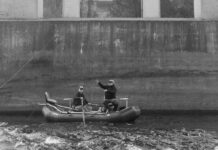Baitcasting for kayak fishing may seem to be an expert skill, but you can get started in minutes. Not so long ago I had zero idea how to cast a baitcaster, but now I can hold my own against even the top kayak fishing pros and act like I’ve always casted like an expert. How?
The truth is there have been some serious backlashes in my past and I’m confident there will be many more in my future. That’s just a part of fishing with a baitcaster, so stop worrying about it. You can start fishing with one of these reels right now, and still look like you know what you’re doing with these helpful tips.

How to Cast a Baitcaster
Casting a baitcaster is all about understanding when to stop the spool from spinning and how much pressure to apply. Other than that, it’s the exact same cast as one with a spinning rod in your hand.
The Basics of Casting a Baitcaster
The basic concept goes like this: you click a button to make the reel go into free spool (or almost free spool, see the braking section below), then you cast the lure like a regular spinning rod, but before the spool can roll over the loose line and create a backlash, you depress your thumb on top of the spool to keep the line tight. Sounds simple enough and it is—after a few tries.
Instead of depressing your thumb the second the lure hits the water, try stopping the line from unspooling right before the lure hits the water, before it has time to decelerate. This will ensure your line is still tight when the lure hits the water, and it won’t allow the spool to wrap line over loose line to create a backlash. The timing that it takes to let go of the spool on your cast is the same timing you need to release the line when casting a spinning rod. With very little practice, you’ll be able to build that muscle memory in no time.

Pump the Brakes to Practice Your Baitcasting
In the beginning, strong brakes are your friend. Use them wisely and you can start fishing with a baitcaster right away, even if you have no idea how to cast at first. Find out how to turn up the brakes when you first get your brand new baitcaster, which will shorten your casting distance and also prevent you from backlashing. The higher the brakes, the more pressure the reel puts on your line and the smoother your casts will be.
As your casting ability starts to develop, slowly turn down the braking power until you can cast without any braking on your line, allowing the maximum distance to your casts. I’ll admit it—even now I can’t cast with 100% free spool (zero braking on the spool), but I know a few anglers that can. The control they have attained over years of casting baitcasters is quite amazing to watch. With enough practice any angler can reach that level of skill, you just have to put in the practice time (and don’t forget to use the brakes at first).

Tips on Dealing with Backlash
When it comes to understanding backlash, you’re mostly on your own. I’ll never understand how line can create a knot underneath ten layers of line—it’s black magic. But the worse thing to do when learning to cast a baitcaster is being afraid of backlash. Don’t worry, you’re going to backlash eventually, it’s not a big deal, just get over the fear of it. Just because you backlash doesn’t mean your day is ruined on the water. It also doesn’t mean you suck at fishing, because—as much as they’d never admit it—even the top bass fishing pros, with all their fancy gear, backlash every once in a while.
How do I know the pros backlash too? I learned a trick from the top pros that will fix your backlash fast, and that means they’ve spent more than enough time clearing their own backlash in order to figure out a better way to fix it. Essentially the trick is to reel over your backlash and then re-cast. I know it sounds backwards and like it’ll make the backlash worse, but nine times out of ten it works. Seriously, give it a try.
The author winds up the baitcaster to demonstrate his casting prowess. | Feature Photo: Ben Duchesney







What rod is that, first picture, it looks parabolic, very hard to find an affordable one. I prefer the slow deep bend loading of parabolic, especially into the wind.